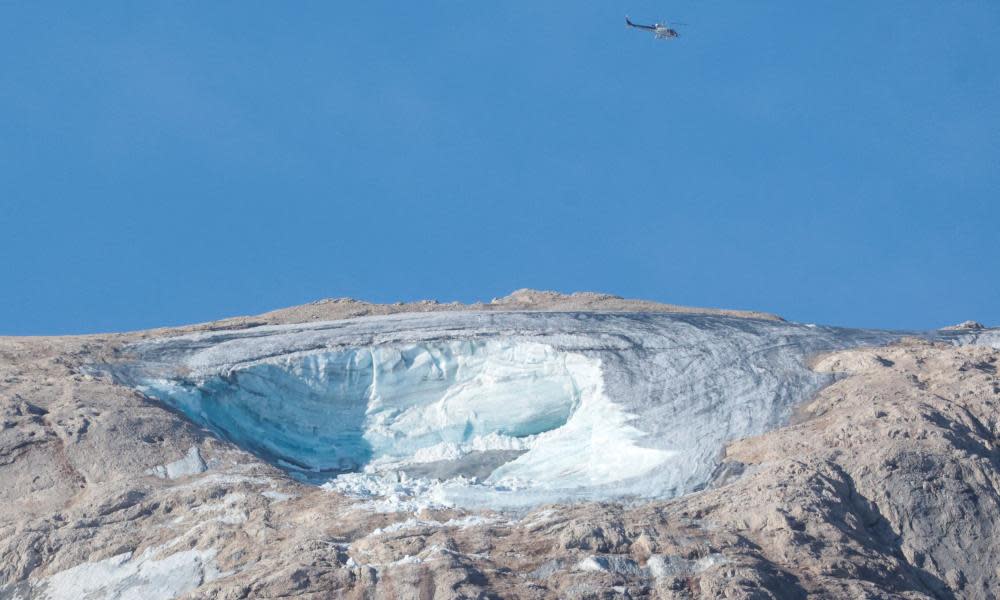Events like Italian glacier collapse likely to increase as planet heats

Events like the collapse of a glacier on the Marmolada mountain, which has killed at least seven people, are likely to become more common as the planet heats, according to scientists who spend their life scrutinising the ice on mountains.
With this particular glacier, experts have pointed to the scorching heatwave in Italy as a factor, as it is likely to have melted large amounts of ice.
Walter Milan, a spokesperson for the National Alpine and Cave Rescue Corps, emphasised how hot it has been. He noted that temperatures in recent days on the peak had topped 10C (50F). “That’s extreme heat” for the peak, he said. “Clearly it’s something abnormal.”
Experts at Italy’s national research council have said the glacier would not exist any more in the next 25-30 years, and much of its volume has already been lost.
Prof Jonathan Bamber, director of the Bristol Glaciology Centre at the University of Bristol, said: “The Dolomites in Italy, where this tragic accident occurred, experienced a drought throughout the winter with very little snowfall. Combined with the unusually high temperatures across the region over the summer, glaciers are melting fast. The section that broke off was part of a hanging glacier with seracs or ice cliffs that become particularly unstable during in warm conditions such as those in the Dolomites right now.”
This story will become more familiar in years to come, as these conditions are being mirrored across mountain ranges.
Glaciologist Prof Poul Christoffersen from the University of Cambridge said: “The Marmolada glacier collapse is a natural disaster linked directly to climate change. High elevation glaciers such as the Marmolada are often steep and relying on cold temperatures below zero degrees Celsius to keep them stable. But climate change means more and more meltwater, which releases heat that warms up the ice if the water re-freezes, or even worse: lifting up the glacier from the rock below and causing a sudden unstable collapse. Catastrophic glacier collapses such as this are becoming more frequent.”
We know that our planet is heating, and that ice around the globe is melting, but the way warmer temperatures impact ice structures on mountains is complex, with multiple factors making glaciers weaker and more likely to cause a deadly avalanche.
Researcher Jacques Mourey works at the Université de Lausanne in Switzerland, where he studies the impact of climate change on sports and nature-based tourism in the mountains.
The heatwave may have been the trigger for the avalanche but the longer-term impact of climate change probably weakened the glacier to the point where it collapsed under pressure, he said.
“When the glacier melts, it means there is melting water that goes all the way down to the bottom of the glacier, when it gets to the bottom of the rock it causes the ice to slide and this causes an avalanche,” he explained.
“This is probably the triggering element but if you look at the pictures you can see there is a big crevice in the upper part that collapsed. The fact that there is a crevice, it shows that the upper part at the front was not connected to the bottom part. If there was not a crevice probably nothing would have happened.”
He said this indicated that the glacier has probably been weakened by warmer temperatures.
“As it’s getting warmer and warmer, the ice is getting less and less strong, it’s getting weaker. If you take ice that is -8C, if you try to break it, it will be much more difficult than breaking ice that is exactly 0C.”
Because of these weakening structures on the mountains, those who climb are increasingly taking their safety into their hands, he said.
“We showed already that some areas have become too dangerous or too difficult for mountaineers to access, climate change is already really impacting mountaineering,” Mourey added.

 Yahoo Movies
Yahoo Movies 
